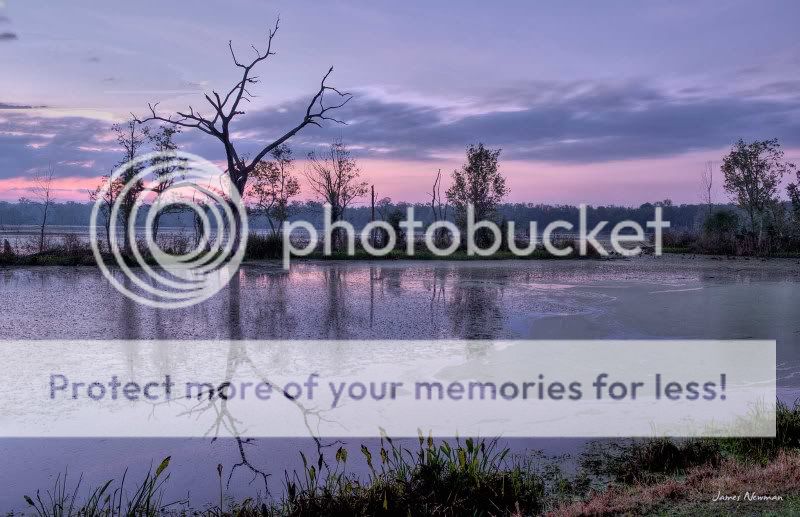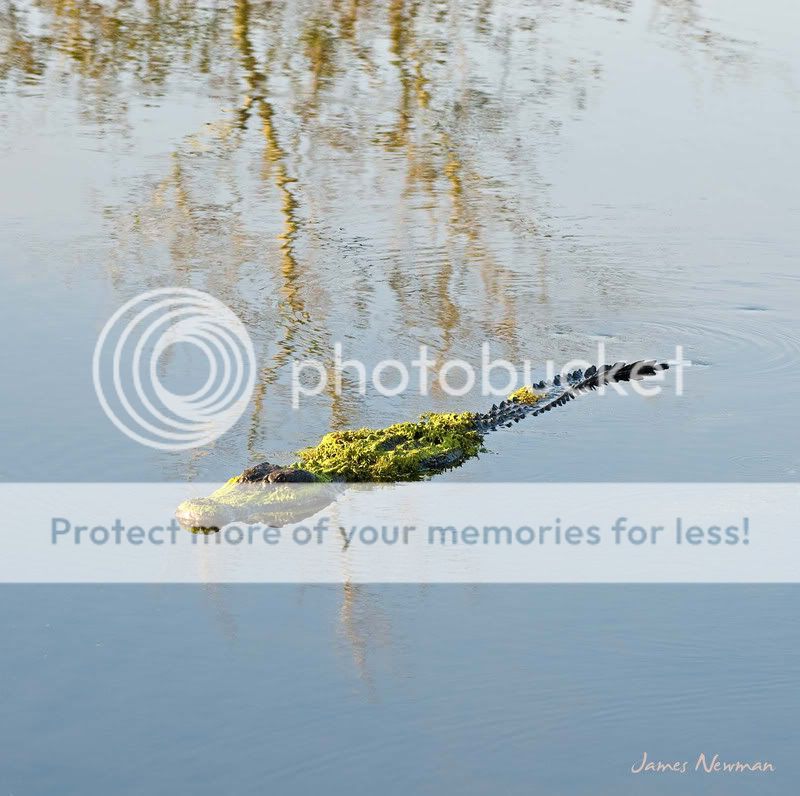I was finally able to visit my favorite local place to shoot, Brazos Bend State Park, for the first time since hurricane Ike blew through.................
And this was a messy looking gator covered in moss that came swimming up.
James,
There has to be a compelling esthetic reason to have one's subject bang in the center of the field! However, in this case, there are special needs to consider more width anyway. So thanks for generously allowing me to show a wider derivative of your fine work. I love your gator. I asked myself, how would it be expanding this to the right to add more water also extending the reflections of the golden branches below the 'gator a wee bit?
I have a constant criticism for photographers shooting as if they are composing exactly as we would print. The thing is that we have much more time at home. Ansel Adams spent many, many hours, sometimes years on location, returning to exploit a new lighting until his dream came to be a print. We have zooms that allow us to rapidly frame scenes. My suggestion is always use the same settings on manual and take adjacent environmental shots so these can be stitched if needed, or else just go wider. Of course, this advice does not apply for pros who routinely
do frame as they will deliver.
The idea is to get some unity in a picture,”wholeness". Here with this gator, the wickedness of it is that in one sweep of its tail it can overtake and seize its prey. So we'd like to see more of its length in respect to the width of the picture. That's where the power is demonstrated. A narrow image confines the killer as a fleeting object. Extra waterway demonstrates what has been already traversed. This picture has a painterly effect of the golden reflections of the branches broken in the water by the ripples from the beast’s sly movement. That must be preserved.
I simply added width to the image in Image, Canvas Size and expanded to the right. Then I copied that to a new layer by dragging the background layer to the icon next to the wastebasket in the layers panel. I then selected the new area to the right. I clicked on the foreground color and with the magnifying glass icon on the top left of the color picker, selected the mid blue hue of the water near the right border of the picture. I then switched to the clone tool and set that for 60% and used that to steal color and patterns from the left side to
continue the sense of the left side. So we don't just go horizontally from left to right, rather, looking at the lines and micro-texture of the water, follow and continue those angles and forms. I did this rather quickly, following the initial cloning with a second pass at 18% to get rid of transitions that were still obvious.
I then added the extra branches reflections below the creature so it is rippling through a more serious body of water. These were picked from different parts of the upper image and shown at about 18% intensity by simply reducing the intensity of the layer with the new features.
With the full size image, these changes can be made more carefully and no one would ever know the changes were made. Frankly, some of the great masters did exactly this in the "wet" darkroom whenever they wished.
So, shouldn't we perhaps consider framing more loosely or at least, using the same settings to take extra shots around the chosen composition, so one has ample creative choices? Anyway, that's my feeling and plea, to save the final art for the screen, as long as one is not doing standard product, wedding, stock or other work where you know what the client wants.
Here we ourselves are the client and we need room for a conversation with and within the milieu of the image. Anyway, that is my sense of creative iterative in the evolution of original art. If there is no room for creativity, then one has taken home a beautiful trophy, but a dead trophy, or perhaps, just found art, depending on how much thought went into the snapping the shutter.
Now the 'gater appears to have travelled more. Seems a bit more powerful.
In this picture, the key thing would be first to get off as many shots as possible of the 'gator cruising past and then using the same setting grab the stationary milieu all around it just by fixing the front of the lens and rotating the camera around an imaginary point on the lens to gather a generous neighborhood. Still, with PS and time, one can do very well but it does take more time and skill.
Asher





